
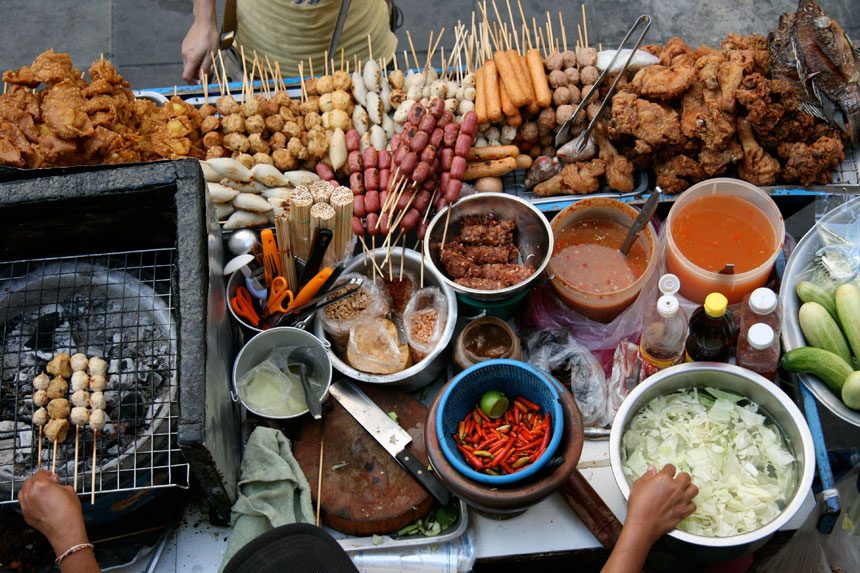 Image credit: J Aaron Farr
Image credit: J Aaron FarrEvery traveler says that the key to enjoy any destination’s traditional cuisine is to eat like a local, to eat where locals eat, or even better, to get invited to a local’s home and be served a home-cooked meal.
That tip rings especially true in Bangkok. It may be difficult to knock on a Thai family’s door and join them for dinner. But do you know what the best thing you could do is? Go crazy on the endless choices of Bangkok street food.
What’s great about exploring street food is that you get to sample traditional Thai food the exact way locals have been preparing it for the past centuries. The authenticity is kept intact because the recipes are not tamed down to suit a tourist’s uninitiated taste buds.
Street food is an important part of Bangkok’s rich culinary heritage, and because it is cooked on the spot, witnessing its preparation is akin to taking a history lesson in the most delicious and affordable way possible. It also lets you interact with the locals so you are afforded a more enriching experience.
If you’re planning a trip to Bangkok, make sure that your itinerary includes a street food exploration. This would be easy to squeeze in while you’re out shopping, looking at majestic temples, or enjoying the crazy nightlife because street food stalls can be found at practically every corner in Bangkok.
Here’s your guide to the best street food in Bangkok and where you can get them at remarkably affordable prices.
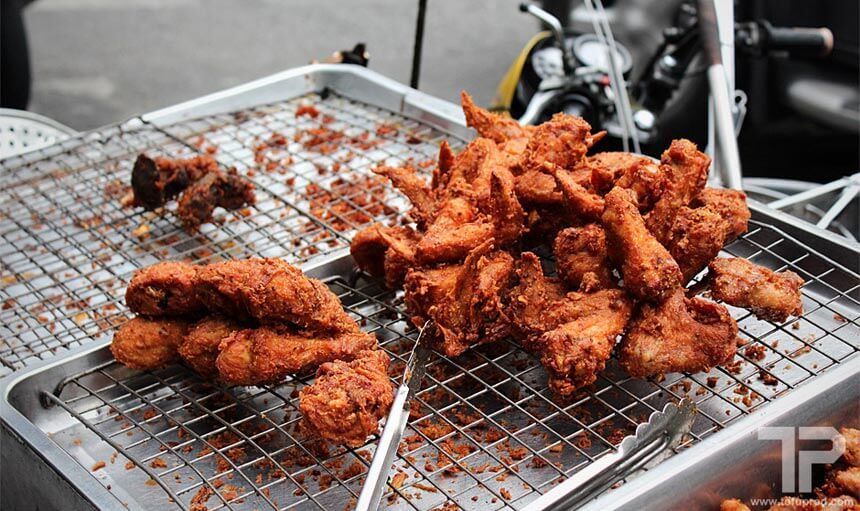 Image credit: tofuprod/Flickr
Image credit: tofuprod/FlickrEverybody loves fried chicken; so much so that you can find a unique recipe in every part of the world.
Thai fried chicken, or gai tod, is a popular street food in Bangkok, revered for its light, crispy skin that crackles with every bite. Hiding beneath that skin is tender juicy flesh made savory by the flavors of soy and fish sauces.
Gai tod is best enjoyed topped with crispy fried garlic and dipped in chili sauce. Wash it down with a cold bottle of Thai beer for the best way to end a day of shopping and sightseeing in the Land of Smiles.
Here are the best places to have fried chicken in Bangkok: Street stalls found on just about every corner; Som Tam Nua restaurant (392/14 Siam Square Soi 5, Rama 1 Road); and Soi Polo Fried Chicken (137/1-2 Soi Sanam Khli).
Price range: 35 – 100 baht ($1.00 – $2.90)
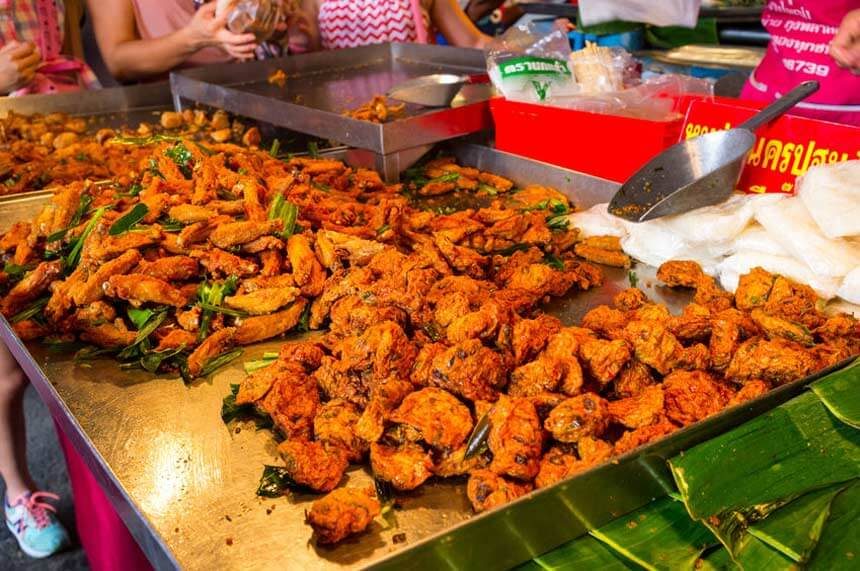 Image credit: lodimup
Image credit: lodimup What makes Thai fish cakes, or tod mun pla krai, exceptionally delicious is the absence of batter that may conceal the fresh flavors of the fish, herbs and spices. Kaffir lime leaves, shrimp paste, and local chili give these fish cakes a distinct Thai flavor.
Sticky rice is optional, but sides of spicy chili sauce, lemon wedges, and diced cucumber are a definite must.
You can have the best Bangkok’s tod mun pla krai at: Chatuchak Market (Kamphaeng Phet 2 Road, Chatuchak); Taling Pling (25 Sukhumvit Soi 34); and Lam Cha-Reon Seafood (999/9 Rama I Road, Pathumwan).
Price range: 20 – 400 baht ($0.60 – $11.50)
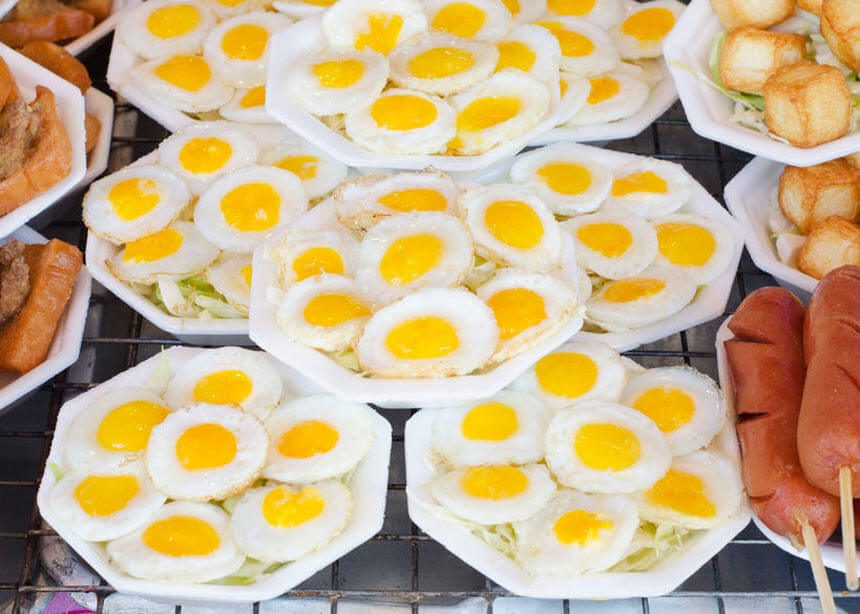 Image credit: mrrath
Image credit: mrrath Fried quail eggs are a street food staple in Bangkok. Locally known as khanom krok khai nok krata, these are a practical choice for when you want your street food hot, fast, and easy to enjoy on-the-go.
These eggs may be tiny, but are actually packed with incredible egg flavor, making them a hit among locals. Plus, the wonderful contrast of the bright yellow yolk against the egg white makes for a cheerful Instagram post.
These delicious quail eggs are cooked sunny side-up in an oil-slicked khanom krok pan, a traditional cast iron griddle. The warm griddle cooks the egg whites all the way through while leaving the yolks soft but not runny.
Once cooked, they are drizzled with a special Thai seasoning sauce and pepper powder, resulting in tiny pockets of goodness oozing with flavor. Douse the freshly-fried quail eggs with a little Sriracha sauce if you like living on the edge.
Here are the best places to enjoy quail eggs in Bangkok: Chinatown (6 Yaowarat Road, Samphanthawong), Ramkhamnhaeng University Night Market (2345/1 Ramkhamnhaeng Road, Hua Mak, Bang Kapi), and Chatuchak Weekend Market (587/10 Kamphaeng Phet 2 Road, Chatuchak).
Price of a plate of quail eggs in these places ranges from 10 baht ($0.30) to 30 baht ($0.90).
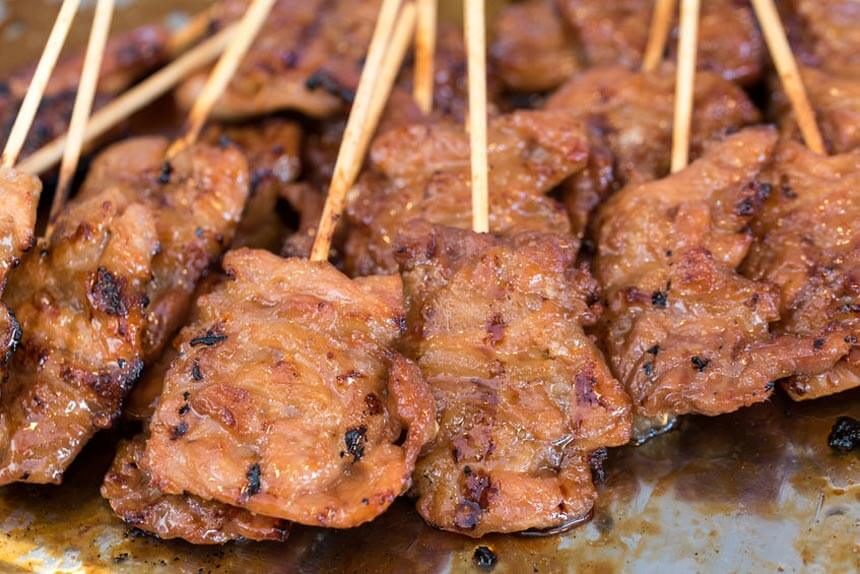 Image credit: napast
Image credit: napast Thai grilled pork, or moo ping as locals would call it, is a definite must-try for every carnivorous traveler.
Succulent pieces of pork meat with fat are skewered together and grilled on top of hot coals. The melting fat dripping on the ambers creates a thick blanket of aromatic smoke that, logically, should drive you away but in reality, lures you even more.
These Thai pork skewers are marinated in a sweet-salty concoction, and when placed on the grill, receive an additional smoky flavor from the burning coals.
The barbecued meat is good enough as it is, but slathered with the homemade spicy sauce, it becomes pure heaven. Moo ping can be enjoyed stick after stick or paired with traditional sticky rice for a more filling meal. Make sure to consume your moo ping hot off the grill when the flavors are most alive and the meat actually melts in your mouth.
Here are the best places to enjoy moo ping in Bangkok: Moo Ping Hea Owen (Silom, Soi Convent), Moo Ping at Sukhomvit (Sukhomvit Soi 19, Watthana), and Chinatown (6 Yaowarat road, Samphanthawong).
Price of a skewer of moo ping in these places ranges from 4 baht ($0.15) to 10 baht ($0.30).
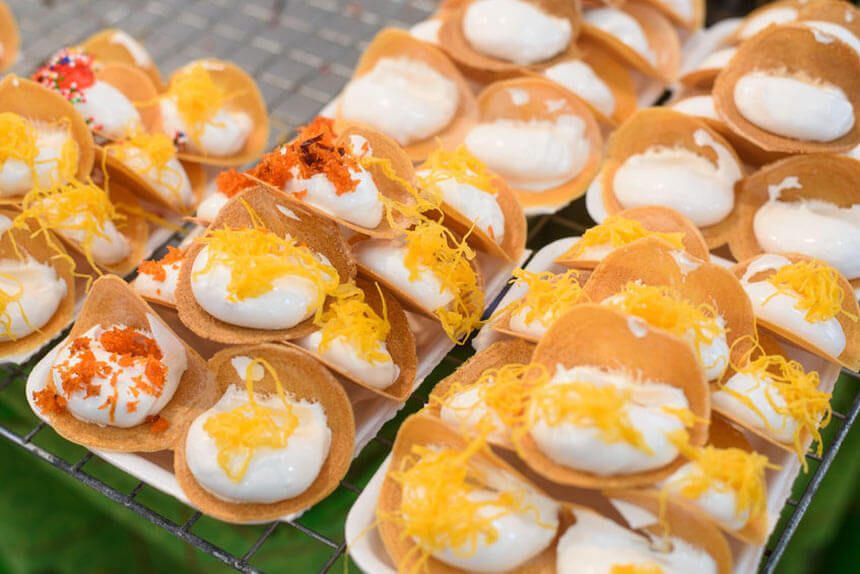 Image credit: otakesang
Image credit: otakesang The history of khanom buang, or Thai crispy pancake, goes as far back as 600 years ago.
It is a traditional sweet street food that entails meticulous preparation. The crispy crepe is made of rice flour, which serves as a delicious vessel to rich meringue topped with candied duck egg yolk.
They say that the best cooks of khanom buang are the elderly, whose ancient recipe they have passed on from generation to generation.
Here are the best places to have crispy pancakes in Bangkok: Khanom Buang Phraeng Nara (Phra Nakhon); Damnoen Saduak Floating Market (Damnoen Saduak District, Ratchaburi); and Siam Paragon (991/1 Rama I Road).
Price range: 10 – 30 baht ($0.30 – $0.90)
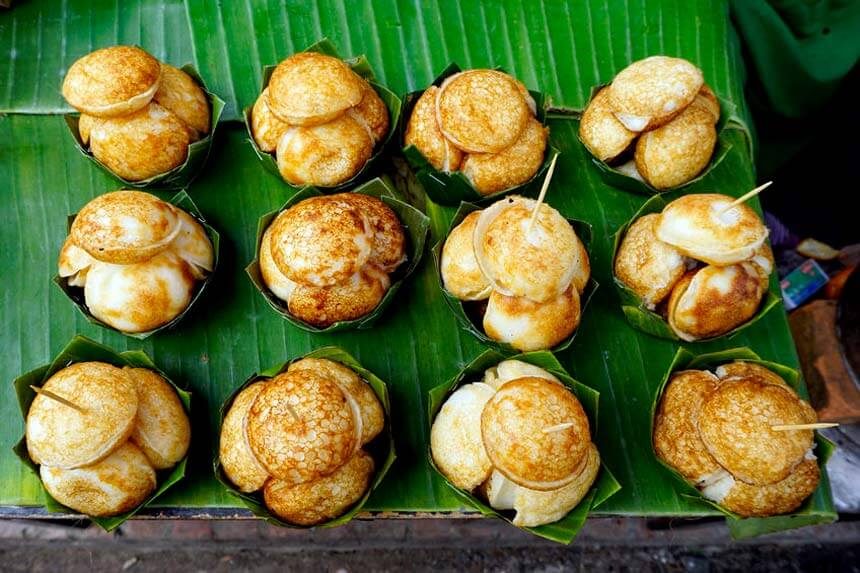 Image credit: polarbearstudio
Image credit: polarbearstudio Kanom Krok is a traditional Thai sweet rice cake that is made with coconut cream and rice flour.
It is a well-loved choice for snack or dessert in Bangkok because of the delightful marriage of flavors. But what makes it even more interesting is the tragic love story behind it. Make sure to ask the kanom krok vendor about the love story with a sad ending that inspired this delightfully sweet dessert, aptly called ‘dessert of love’.
Traditional khanom krok showcases a layer of rice flour topped with another layer of sweet coconut cream to make up a sphere that is both light and crispy. Modern innovations have resulted in the addition of an assortment of toppings such as corn, taro, and spring onions.
Khanom krok is best enjoyed fresh off the khanom krok pan when it’s still piping hot.
Here are the best places to enjoy kanom krok in Bangkok: Ratchawat Market (Thanan Nakhon Chai Si, Dusit), Cicada Night Market (83/159 Nong Kae-Kho Takiap Road, Hua Hin), and Plearn Wan Eco Village (Soi Hua Hin 38-40 Phet Kasem Road, Hua Hin).
Price of a dozen of kanom krok in these places ranges from 15 baht ($0.50) to 30 baht ($0.90).
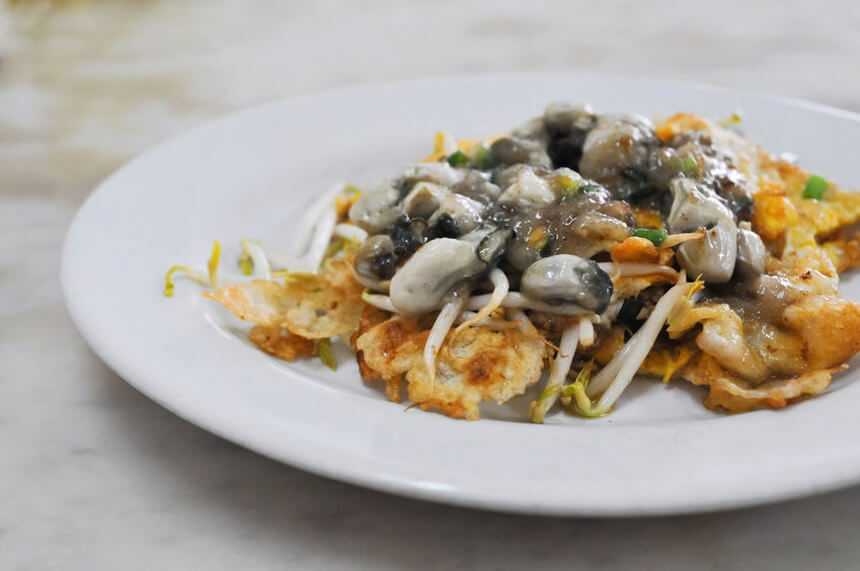 Image credit: pchweat
Image credit: pchweat Once you’ve tried authentic hoy tod on the streets of Bangkok, you’ll find yourself tempted to fly back just for another taste of this traditional oyster omelette.
Hoy tod is crispy, greasy, briny, and is packed full with plump, juicy oysters and fresh bean sprouts in a blanket of savory egg batter.
The dish is often served with an assortment of condiments such as fish sauce with chopped up pieces of fresh chilies, green chili sauce, and sweet tomato sauce. But these are not really necessary as the dish is already flavorful on its own, especially when fresh off the cast iron skillet.
Here are the best places to enjoy hoy tod in Bangkok: Nai Mong Hoi Tod (539 Thanon Phlap Phla Chai, Bombrab Sathupai); Hoi Tod Chaw Lae (Soi Sukhumvit 55, Sukhumvit Road, Khlong Tan); and Thip Volcanic Fried Mussel & Oyster (3, Soi Charoen Krung 50, Charoen Krung Road, Khet Bangrak).
The price of hoy tod in these places range from 50 baht ($1.50) to 70 baht ($2.00).
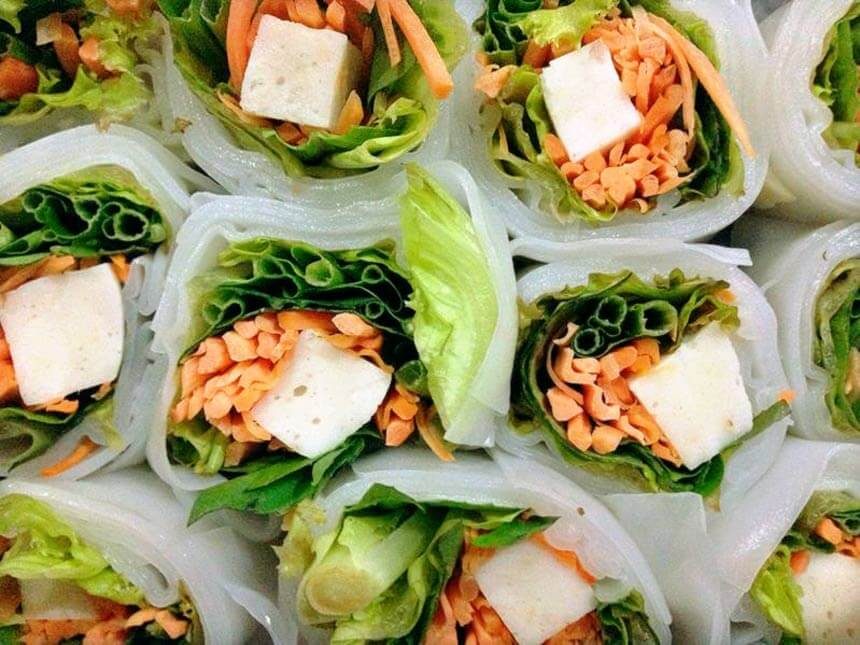 Image credit: envyno
Image credit: envyno Possibly the best thing about the street food in Bangkok is that it makes it easy to eat healthy – an incredible feat when one is on vacation. The streets of Bangkok are replete with healthful dishes that make use of fresh, locally-sourced herbs, spices, and other produce.
Kway Teow Lui Suan, or Thai fresh spring rolls with herbs, is a great example of that.
This healthy food is not a traditional Thai dish but more of an interpretation of the iconic Vietnamese food. This, however, is still a popular street food in Bangkok.
Thais have made this dish their own by using wide rice noodles instead of rice paper, and flavoring it with aromatic herbs. Choice of filling comes in the form of sausage, shrimp, or for a really healthy choice, tofu and mushrooms. Dipping sauce can either be peanut sauce or sweet green chili sauce.
Here are the best places to enjoy kway teow lui suan in Bangkok: Baan Suan Pai (17/1 Phahon Yothin Road, Phaya Thai), Chamlong’s Asoke Vegetarian Restaurant (Chatuchak Market, Kampaeng Phet Road), and Seri Market (L1, 0101, The Nine Neighborhood Center, Thanon Rama Ix, Suan Luang).
The price of kway teow lui suan in these places range from 20 baht ($0.60) to 35 baht ($1.00) for three rolls.
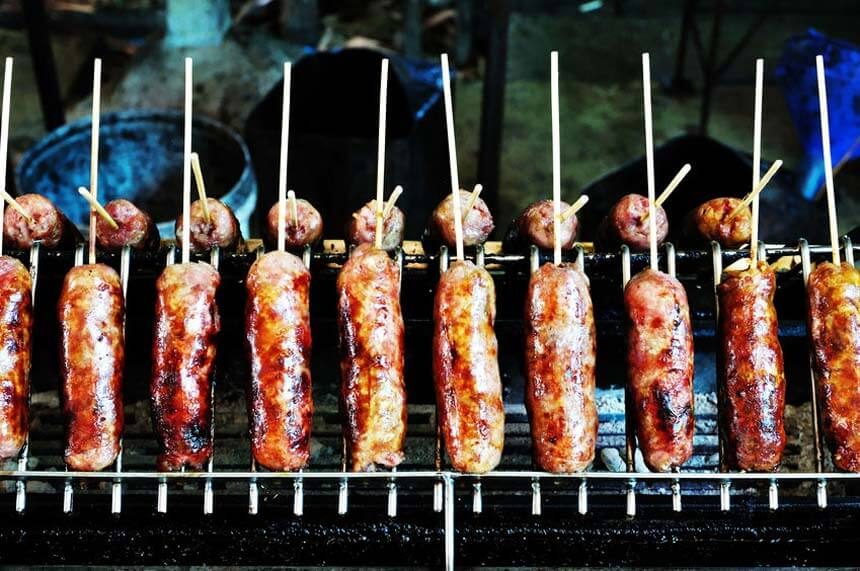 Image credit: thampapon1
Image credit: thampapon1 Sai Oua is a kind of traditional Thai sausage which traces its origins to Northern Thailand.
It has a distinctly intense flavor that you wouldn’t find in other sausages – thanks to the mixture of minced pork, charred makrut lime, galangal, lemongrass, chilies, and other spices. This heady concoction is stuffed in a pork intestine casing – the only way locals do it.
These Thai sausages are sold at grilled meat food carts strewn along the streets of Bangkok. They’re usually on display along with other kinds of meats and sausages, so you have to make it a point to specifically ask for sai oua.
Locals like to eat their sai oua by rolling it in the accompanying green roasted chili paste, or nam phrik noom. The pairing makes for a really spicy combination – a cold bottle of beer in hand would help wash down the spiciness.
Here are the best places to enjoy sai oua in Bangkok: Or Tor Kor Market (139/4 1, Samsen Nai, Phaya Thai); Chatuchak Weekend Market (587/10 Kamphaeng Phet 2 Road, Chatuchak); and Chinatown (6 Yaowarat road, Samphanthawong).
Price of sai oua in these places ranges from 10 baht ($0.30) to 15 baht ($0.43) per stick.
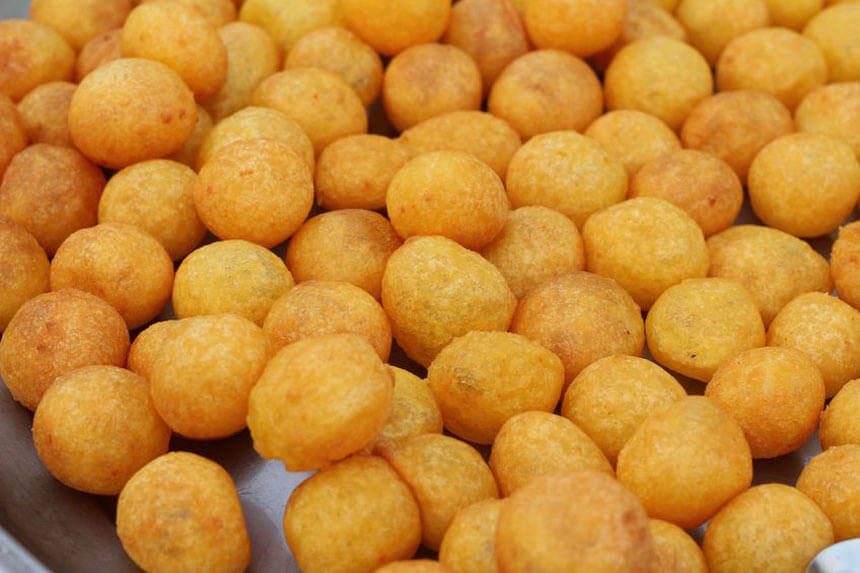 Image credit: seagames50
Image credit: seagames50 Kanom kai nok krata is a snack in Bangkok made of sweet potato, which can be a tad bit confusing because kanom means ‘snack’ in Thai while kai nok krata means ‘quail eggs’. This well-loved street food is named such because its shape and size resembles that of a quail egg. But all resemblance ends there.
Khanom kai nok krata are warm, deep-fried puffy balls of sweet potato, tapioca starch, and sugar. Fresh off the wok, these are crispy on the outside and deliciously soft and airy on the inside. What makes these sweet potato balls unique is the limestone water used in the batter, which makes the exterior really crispy.
Delightful as they are, Thai sweet potato balls are not a common find on the streets of Bangkok. This is why you should definitely buy yourself several pieces the moment you see a kanom kai nok krata cart.
Here are the best places to enjoy kanom kai nok krata: Sukhumvit Soi 38 (Sukhumvit 38 Alley, Phra Kanong, Khlong Toei); Soi Petchburi 19 (Petchburi Road, Pratunam); and Silom Complex (4 Silom, Bang Rak).
Price of kanom kai nok krata in these places ranges from 7 baht ($0.20) to 18 baht ($0.50).
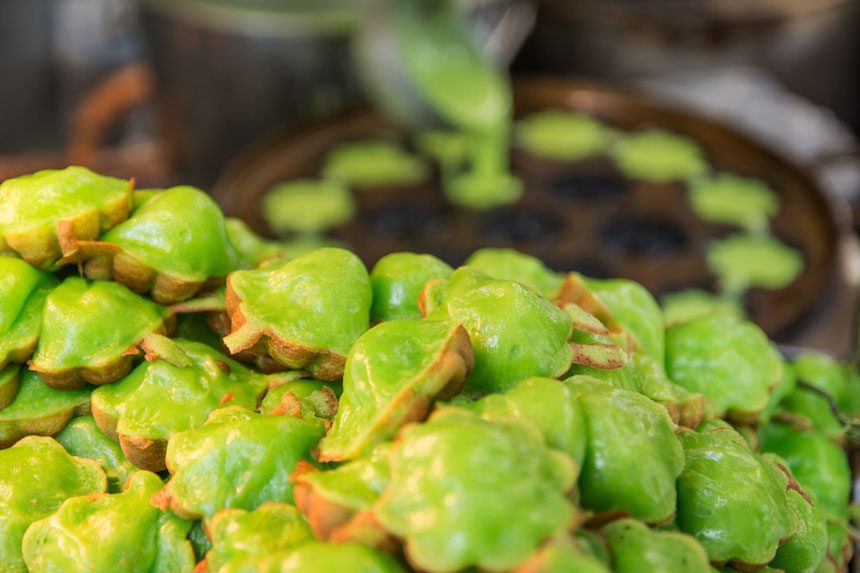
As with other delicious Bangkok street food, kanom krok bai toey tastes best when eaten fresh off the skillet.
This muffin-like snack is made with flour, coconut sugar, and pandan leaf extract, which gives off a bright green color and a heavenly aroma. This pandan sweetmeat is chewy, fluffy and not too sweet – perfect as snack while roaming the streets of Bangkok.
The kanom krok bai toey of today is prepared the same way it was prepared by the ancient Thais centuries ago – in a cast iron griddle called kanom krok, which is placed on top of burning hot coals.
It is a delight watching the deft hands of the vendor skillfully pouring the batter into the skillet and flipping each piece, especially because the fragrance envelopes the air, making you even more excited to get your hands on these tiny green pillows of deliciousness.
Here are the best places to enjoy kanom krok bai toey: Train Market Ratchada (Ratchadaphisek Road, Dindaeng); Wang Lang Market (Soi Wang Lang, Siriraj); and Siam Pandan (Pathum Wan, Bangkok – beside Novotel Siam Square).
Price of kanom krok bai toey in these places ranges from 35 baht ($1.00) to 50 baht ($1.40) for a box of 9.
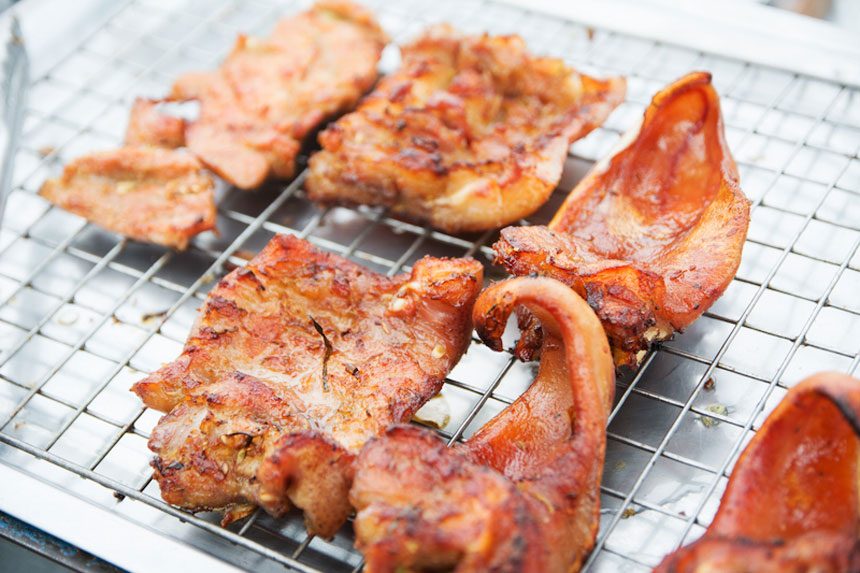
Moo yang is another grilled meat favorite on the streets of Bangkok, a popular fare among locals who want to cap off their day with a few drinks and some good street food.
Pieces of meat are marinated in a formula of honey, fish sauce, soy sauce, and spices, and then grilled on charcoal. The process of marinating and grilling results in tender, juicy pieces packed with sweet-salty-smoky flavor bite after bite.
They are served either skewered or sliced into bite-sized pieces. You can also make a full meal out of it by ordering rice alongside your grilled honey roast pork.
Ask Bangkok locals where you can find the best moo yang and they will quickly answer, “Just follow the smoke.” It’s true though because moo yang carts are distinguished by the fragrant smoke emanating from the burning charcoals sizzling with dripping pork fat.
Your moo yang experience can be made even better by dipping the pork skewers in Thai peanut sauce or green chili sauce.
Here are the best places to enjoy moo yang: Moo Yang Nam Peung (Chatuchak Weekend Market, Area 22, Soi 4, Kamphaeng Phet 2 Road, Chatuchak); Soi Convent (Convent Road); and Ratchawat Market (Nakhon Chaisi Road, Bangkok).
Price of moo yang in these places ranges from 4 baht ($0.10) to 9 baht ($0.25).
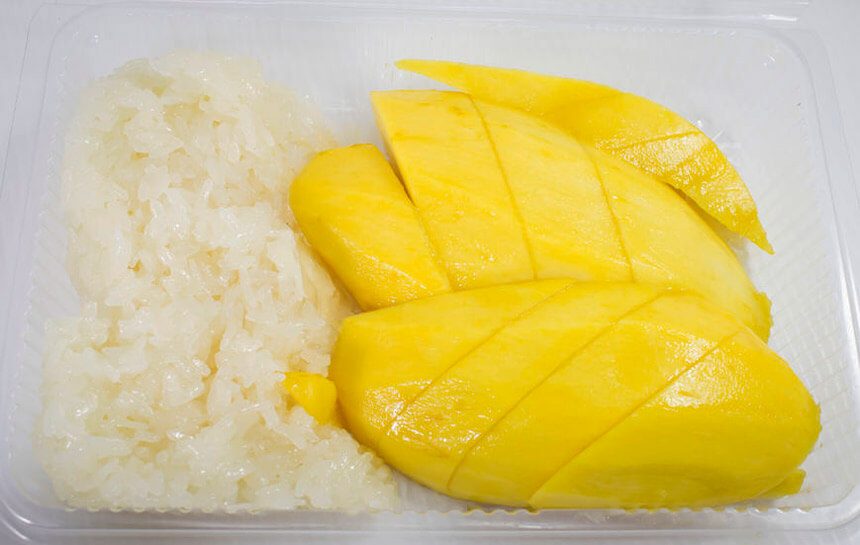 Image credit: kamontad123
Image credit: kamontad123 No trip to Bangkok is complete without a taste – or an indulgence, to be honest – of khao niao mamuang or mango sticky rice.
It is one of the most popular sweet street foods in Bangkok, a favorite among both locals and tourists. To the uninitiated, the combination of rice and mango in a dish does not sound delectable, but Thais have managed to marry these two ingredients in a delicious, sweet snack.
Fluffy glutinous rice is served alongside fleshy cheeks of ripe mango and then smothered with rich coconut cream syrup.
If you had to limit your dessert intake to just one dish, you definitely should go for khao niao mamuang – if only for the Thai mangoes, which are famous for being among the sweetest mangoes in the world.
Here are the best places to enjoy khao niao mamuang: Wantana Khanom Thai (Ratchawat Market, Nakhon Chaisri Road); Mae Varee Fruit Shop (1 Soi Thong Lor Road, Sukhumvit 55 Klongtunnua Wattana); and Pratunam (Soi Petchaburi 30, New Petchaburi Road, Makkasan, Ratchawithi).
Price of khao niao mamuang in these places ranges from 100 baht ($2.90) to 145 baht ($4.20).
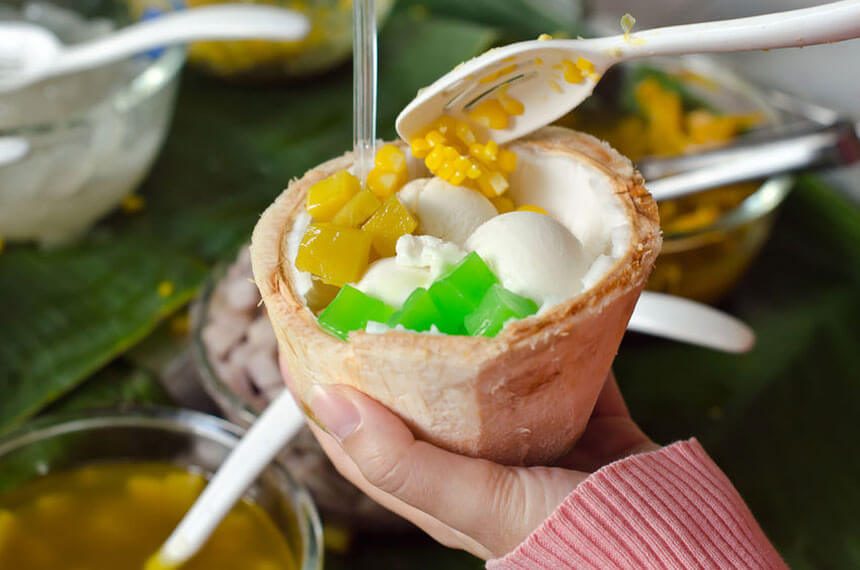 Image credit: suradechk
Image credit: suradechk The Bangkok heat can be a great challenge when you have an entire day of touring and shopping planned. Don’t worry, because the warm climate is actually the perfect excuse to stop for a refreshing Thai coconut ice cream.
It was the Europeans who introduced ice cream to this Southeast Asian country, but the locals didn’t waste time making the refreshment their own.
What makes Thai coconut ice cream different from all the other ice creams is the use of rich coconut cream as its base instead of the usual cow’s milk. The creamy coconut base is generously sprinkled with real coconut bits whose texture is a wonderful contrast against the smooth creaminess.
Nowadays, it is not unusual to see Thai coconut ice cream topped with kernels of corn, toasted peanuts, or cubes of sweet jelly. You can even buy Thai coconut ice cream sandwiched in between pieces of bread!
Here are the best places to enjoy Thai coconut ice cream in Bangkok: Nattaporn Ice Cream (Phraeng Phuthon, Phra Nakhon); Chatuchak Market (Kamphaeng Phet 2 Road, Chatuchak); and Baan Peeraka (41/37 Romklao Road, Min Buri).
Price of Thai coconut ice cream in these places ranges from 12 baht ($0.35) to 20 baht ($0.58).
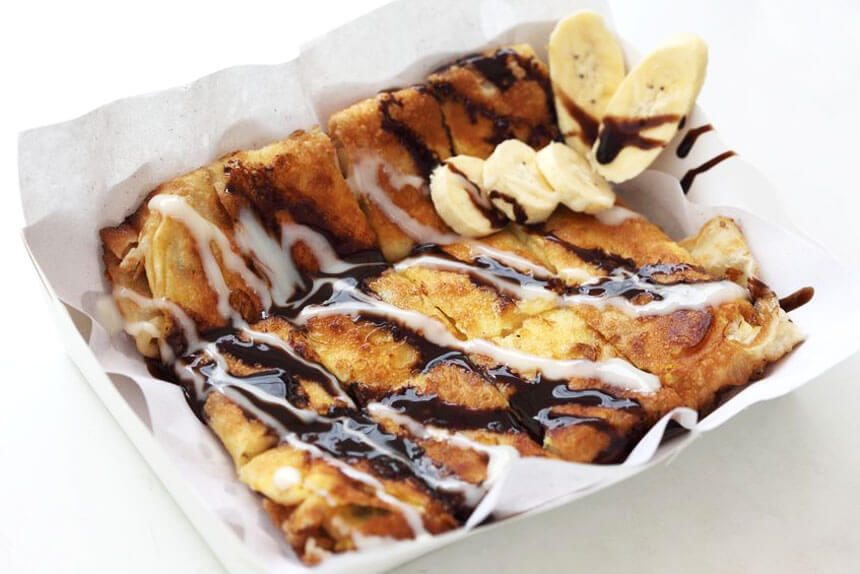 Image credit: tawintaew
Image credit: tawintaew Roti is another dish that does not really have Thai origins but has been embraced by the locals; so much so that it has become one of the most craved street snacks in Bangkok. Roti gluay, or fried banana pancake, is just one of the variants of roti peddled in carts at just about every corner of the city.
The preparation of roti gluay can be hypnotizing to watch – with the skillful hands of the vendor maneuvering the ingredients with such panache and quickness. Dough is laid flat on an iron skillet, which is then to fulfill its role as a crispy blanket to the creamy mixture of banana slivers and egg. The roti gluay is chopped into smaller pieces and served with a hefty drizzle of sweet condensed milk.
Here are the best places to enjoy roti gluay: Soi Rangnam (Phaya Thai, Ratchathewi); and Sukhumvit Soi 38 (Sukhumvit 38 Alley, Phra Khanong, Khlong Toei).
Price of roti gluay in these places ranges from 15 baht ($0.43) to 30 baht ($0.86).